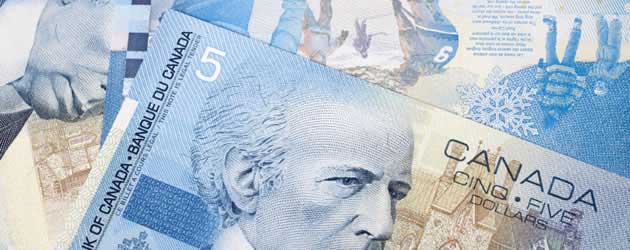
Although positive UK news kept the Canadian Dollar trading lower against its British counterpart, the ‘Loonie’ was able to advance on its US rival as the price of crude oil (a major Canadian export) surged above $100 a barrel.
The Canadian Dollar Exchange Rate was in the region of 0.6211 against the British Pound as of 14:55 GMT
The price rise was largely the result of supply concerns (due to the turmoil in Egypt) and declining US reserves. Yesterday the American Petroleum Institute announced that crude inventories dropped by 9.4 million barrels last week.
In response to the ‘Loonie’s gain on the US Dollar, Toronto-based macro strategist David Tulk commented: ‘The price of oil is up over 100 bucks a barrel. CAD insofar as it’s a commodity play at moments in time, I think that’s probably what’s contributing to the relative outperformance of the Canadian Dollar.’
However, the commodity driven currency went on to shed its advance as political splits in Portugal brought focus back to the Eurozone crisis and encouraged investors to turn to safe-haven assets.
Meanwhile, a report published by Statistics Canada showed that the nation’s merchandise imports dropped by 3.2 per cent in May. As exports fell by 1.6 per cent Canada’s trade deficit with the rest of the world fell from April’s 951 million Dollars to 303 Million Dollars.
The CAD/GBP exchange rate hit a low of 0.6197
Despite weakening to its lowest level against the US Dollar since the last quarter of 2011 yesterday, some industry experts are intimating that the ‘Loonie’ has further to fall.
According to one industry expert, the currency’s declines in the second quarter: ‘highlight the asymmetry that marks CAD movement, in that strength occurs at a much more moderate pace relative to weakness, which tends to be rapid. CAD movement in Q2 2013 was primarily driven by shifting external factors, specifically the outlook for Fed policy and its resultant volatility, but also the expectation for global growth.’
Over in the US a report showed an unexpected surge in the US trade deficit in May. With imports achieving their second highest level ever, the gap expanded to 45 billion Dollars in May, a 12.1 per cent increase on the 40.1 billion Dollar deficit recorded in April.
The result prompted economist Robert Rosener to observe: ‘We are seeing a pickup in demand on the consumer side that’s boosting imports. The US will keep growing faster than other areas of the world. We don’t see a huge rise in exports, but expect a big gain in imports.’
Separate data showed that US payrolls increased by 188,000 last month, better than the 160,000 forecast.
The Canadian Dollar declined against the Pound after the British currency broadly strengthened in response to stronger than expected UK services PMI.
Current Canadian Dollar (CAD) Exchange Rates
< Down > Up
The Canadian Dollar/US Dollar Exchange Rate is currently in the region of: 0.9470 <
The Canadian Dollar /Euro Exchange Rate is currently in the region of: 0.7308 <
The Canadian Dollar/Pound Sterling Exchange Rate is currently in the region of: 0.6211 <
The Canadian Dollar/Australian Dollar Exchange Rate is currently in the region of: 1.0457 >
The Canadian Dollar /New Zealand Dollar Exchange Rate is currently in the region of: 1.2209 >
The Pound Sterling/Canadian Dollar Exchange Rate is currently in the region of: 1.6091 >
The US Dollar/ Canadian Dollar Exchange Rate is currently in the region of: 1.0560 >
The Euro/Canadian Dollar Exchange Rate is currently in the region of: 1.3689 >
The New Zealand Dollar/Canadian Dollar Exchange Rate is currently in the region of: 0.8188 <
The Australian Dollar/Canadian Dollar Exchange Rate is currently in the region of: 0.9566 <
(Correct as of 14:55 GMT)

Comments are closed.